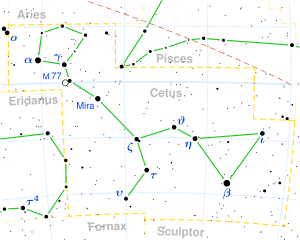Upsilon Ceti
 | |
| Observation data Epoch J2000.0 Equinox J2000.0 (ICRS) | |
|---|---|
| Constellation | Cetus |
| Right ascension | 02h 00m 00.30916s[1] |
| Declination | −21° 04′ 40.1946″[1] |
| Apparent magnitude (V) | 3.95[2] |
| Characteristics | |
| Spectral type | M0III[3] |
| U−B color index | +1.90[2] |
| B−V color index | +1.57[2] |
| Astrometry | |
| Radial velocity (Rv) | +18.00±0.70[4] km/s |
| Proper motion (μ) | RA: +134.92[1] mas/yr Dec.: −24.59[1] mas/yr |
| Parallax (π) | 11.14 ± 0.18[1] mas |
| Distance | 293 ± 5 ly (90 ± 1 pc) |
| Absolute magnitude (MV) | −0.77[5] |
| Details[6] | |
| Mass | 1.26±0.13 M☉ |
| Radius | 53.56±11.80 R☉ |
| Luminosity | 549.6±226.8 L☉ |
| Surface gravity (log g) | 1.15±0.18 cgs |
| Temperature | 3,822±148 K |
| Metallicity [Fe/H] | −0.06±0.10 dex |
| Age | 6.97±2.77 Gyr |
| Other designations | |
| Database references | |
| SIMBAD | data |
Upsilon Ceti, Latinized from υ Ceti, is a solitary[8] star in the equatorial constellation of Cetus. It is visible to the naked eye with an apparent visual magnitude of 3.95.[2] Based upon an annual parallax shift of 11.14 mas,[1] it is located about 293 light years from the Sun.
This star was designated Upsilon Ceti by Bayer and 59 Ceti by Flamsteed. Flamsteed also gave it the designation Upsilon2 Ceti to distinguish it from 56 Ceti, which he called Upsilon1. Flamsteed's superscripted designations, however, are not in general use today.[9]
For ancient Arabic astronomers, this star with η Cet (Deneb Algenubi), θ Cet (Thanih al Naamat), τ Cet (Durre Menthor) and ζ Cet (Baten Kaitos), formed Al Naʽāmāt (ألنعامة), the Hen Ostriches[10] In Chinese, 鈇鑕 (Fū Zhì), meaning Sickle, refers to an asterism consisting of υ Ceti, 48 Ceti and 56 Ceti.[11] Consequently, υ Ceti itself is known as 鈇鑕四 (Fū Zhì sì, English: the Fourth Star of Sickle.)[12]
Upsilon Ceti is a evolved red giant star with a stellar classification of M0III and is listed as a standard for that class.[3] The star has previously been classified as K5/M0III,[13] an interesting example of one of the "gaps" in the Morgan-Keenan classification system, with K6-9 often not used for giant stars or used only to indicate a fraction of the way between K5 and M0.[3]
There is an 84% chance that it is on the red giant branch, or 16% to be on the horizontal branch. Stellar models based on the red giant branch status yield an estimated mass of around 126% of the Sun's mass and 54 times the radius of the Sun. This model indicates the star radiates around 550 times the solar luminosity from its outer atmosphere at an effective temperature of 3,822 K.[6]
References
- 1 2 3 4 5 6 van Leeuwen, F. (2007), "Validation of the new Hipparcos reduction", Astronomy and Astrophysics, 474 (2): 653–664, arXiv:0708.1752, Bibcode:2007A&A...474..653V, doi:10.1051/0004-6361:20078357.
- 1 2 3 4 Mermilliod, J.-C. (1986), "Compilation of Eggen's UBV data, transformed to UBV (unpublished)", Catalogue of Eggen's UBV data, SIMBAD, Bibcode:1986EgUBV........0M.
- 1 2 3 Keenan, Philip C; McNeil, Raymond C (1989). "The Perkins catalog of revised MK types for the cooler stars". Astrophysical Journal Supplement Series. 71: 245. Bibcode:1989ApJS...71..245K. doi:10.1086/191373.
- ↑ de Bruijne, J. H. J.; Eilers, A.-C. (October 2012), "Radial velocities for the HIPPARCOS-Gaia Hundred-Thousand-Proper-Motion project", Astronomy & Astrophysics, 546: 14, arXiv:1208.3048, Bibcode:2012A&A...546A..61D, doi:10.1051/0004-6361/201219219, A61.
- ↑ Anderson, E.; Francis, Ch. (2012), "XHIP: An extended hipparcos compilation", Astronomy Letters, 38 (5): 331, arXiv:1108.4971, Bibcode:2012AstL...38..331A, doi:10.1134/S1063773712050015.
- 1 2 Reffert, Sabine; et al. (2015), "Precise radial velocities of giant stars. VII. Occurrence rate of giant extrasolar planets as a function of mass and metallicity", Astronomy and Astrophysics, 574A (2): 116–129, arXiv:1412.4634, Bibcode:2015A&A...574A.116R, doi:10.1051/0004-6361/201322360.
- ↑ "ups Cet -- Star", SIMBAD Astronomical Database, Centre de Données astronomiques de Strasbourg, retrieved 2017-02-12.
- ↑ Eggleton, P. P.; Tokovinin, A. A. (September 2008), "A catalogue of multiplicity among bright stellar systems", Monthly Notices of the Royal Astronomical Society, 389 (2): 869–879, arXiv:0806.2878, Bibcode:2008MNRAS.389..869E, doi:10.1111/j.1365-2966.2008.13596.x.
- ↑ Wagman, Morton (2003). Lost Stars. The McDonald & Woodward Publishing Company. p. 106. ISBN 0-939923-78-5.
- ↑ Allen, R. H. (1963), Star Names: Their Lore and Meaning (Reprint ed.), New York: Dover Publications Inc., p. 162, ISBN 0-486-21079-0, retrieved 2010-12-12
- ↑ (in Chinese) 中國星座神話, written by 陳久金. Published by 台灣書房出版有限公司, 2005, ISBN 978-986-7332-25-7.
- ↑ (in Chinese) AEEA (Activities of Exhibition and Education in Astronomy) 天文教育資訊網 2006 年 7 月 10 日
- ↑ Houk, Nancy; Smith-Moore, M. (1978), Michigan catalogue of two-dimensional spectral types for the HD stars, 4, Ann Arbor: Dept. of Astronomy, University of Michigan, Bibcode:1988mcts.book.....H.
External links
- Kaler, James B. (November 4, 2011), "Upsilon Ceti", Stars, University of Illinois, retrieved 2017-02-13.
- "* ups Cet". SIMBAD. Centre de données astronomiques de Strasbourg.
- http://www.alcyone.de/cgi-bin/search.pl?object=HR0585
- http://server3.wikisky.org/starview?object_type=1&object_id=714